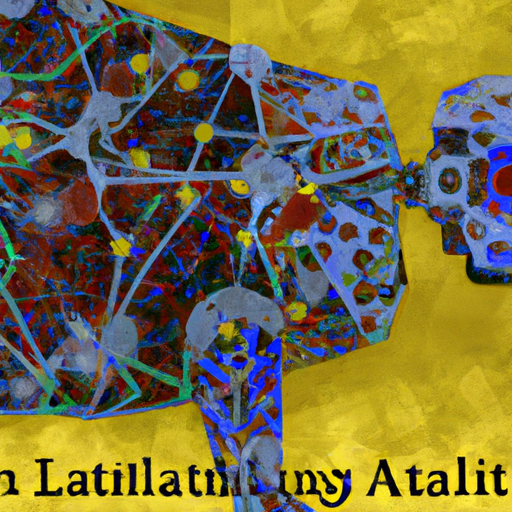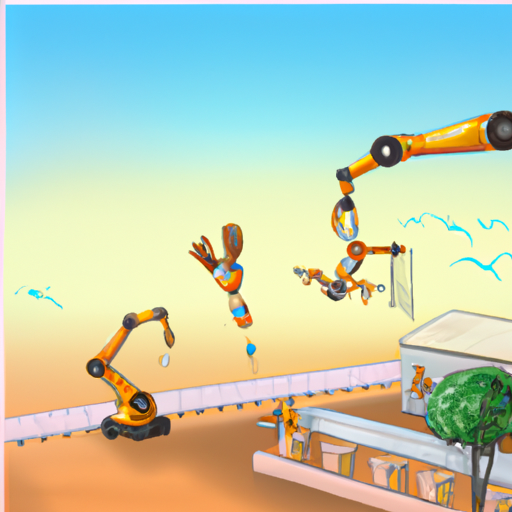-
Table of Contents
- Introduction
- The Future of AI and ML in Automation Systems: What to Expect
- The Impact of AI and ML on Automation Efficiency
- The Challenges of Integrating AI and ML into Automation Systems
- How AI and ML are Transforming the Automation Industry
- Exploring the Benefits of AI and ML Integration in Automation Systems
- Conclusion
“Unlock the Future of Automation with AI and ML Integration!”
Introduction
The integration of Artificial Intelligence (AI) and Machine Learning (ML) into robots and automation systems is revolutionizing the way we interact with machines. AI and ML are enabling robots to learn from their environment and make decisions based on the data they receive. This has enabled robots to become more autonomous and efficient, allowing them to take on more complex tasks. AI and ML are also being used to improve the accuracy and speed of automation systems, allowing them to complete tasks faster and more accurately. The integration of AI and ML into robots and automation systems is transforming the way we interact with machines and is paving the way for a new era of automation.
The Future of AI and ML in Automation Systems: What to Expect
The future of Artificial Intelligence (AI) and Machine Learning (ML) in automation systems is an exciting prospect. AI and ML are rapidly becoming integral components of automation systems, and their potential to revolutionize the way we interact with technology is immense. As AI and ML continue to evolve, automation systems will become increasingly sophisticated and capable of performing complex tasks with minimal human intervention.
In the near future, AI and ML will be used to automate mundane tasks, such as scheduling, data entry, and customer service. Automation systems will be able to analyze large amounts of data and make decisions based on the results. This will enable businesses to make more informed decisions and increase efficiency. AI and ML will also be used to automate more complex tasks, such as predictive analytics and natural language processing. This will allow automation systems to understand and respond to customer inquiries in a more natural way.
In addition, AI and ML will be used to create more intelligent robots. These robots will be able to interact with humans in a more natural way, and they will be able to learn from their experiences. This will enable robots to become more autonomous and capable of performing complex tasks without human intervention.
Finally, AI and ML will be used to create more intelligent and efficient automation systems. Automation systems will be able to learn from their experiences and adapt to changing conditions. This will enable them to become more efficient and reliable, and they will be able to respond to customer inquiries in a more timely manner.
The future of AI and ML in automation systems is an exciting prospect. As AI and ML continue to evolve, automation systems will become increasingly sophisticated and capable of performing complex tasks with minimal human intervention. This will enable businesses to make more informed decisions and increase efficiency, while also providing customers with a more natural and efficient experience.
The Impact of AI and ML on Automation Efficiency
The impact of Artificial Intelligence (AI) and Machine Learning (ML) on automation efficiency is undeniable. AI and ML are two of the most powerful tools available to automate processes and increase efficiency. AI and ML are used to automate tasks that would otherwise require manual labor, such as data entry, customer service, and even medical diagnosis.
AI and ML are used to automate processes by using algorithms to analyze data and make decisions. AI and ML algorithms can be used to identify patterns in data, detect anomalies, and make predictions. This allows for more accurate and efficient automation of processes. AI and ML can also be used to automate tasks that require human judgment, such as customer service and medical diagnosis.
AI and ML can also be used to optimize processes. AI and ML algorithms can be used to identify the most efficient way to complete a task. This can help reduce the amount of time and resources needed to complete a task. AI and ML can also be used to identify areas of improvement in processes, allowing for more efficient automation.
The use of AI and ML in automation has already had a significant impact on efficiency. Automation has allowed businesses to reduce costs, increase productivity, and improve customer service. AI and ML have also enabled businesses to automate processes that would otherwise require manual labor, such as data entry and customer service.
The impact of AI and ML on automation efficiency is expected to continue to grow in the future. As AI and ML become more advanced, they will be able to automate more complex tasks and processes. This will allow businesses to further reduce costs and increase efficiency.
In conclusion, the impact of AI and ML on automation efficiency is undeniable. AI and ML are powerful tools that can be used to automate processes and increase efficiency. AI and ML can also be used to optimize processes and identify areas of improvement. The use of AI and ML in automation has already had a significant impact on efficiency, and this impact is expected to continue to grow in the future.
The Challenges of Integrating AI and ML into Automation Systems
The integration of artificial intelligence (AI) and machine learning (ML) into automation systems is a complex process that presents a number of challenges. AI and ML are powerful tools that can be used to automate processes and improve efficiency, but they must be implemented correctly in order to be effective.
One of the primary challenges of integrating AI and ML into automation systems is the need for accurate data. AI and ML algorithms rely on data to make decisions and predictions, so it is essential that the data used is accurate and up-to-date. If the data is not accurate, the algorithms will not be able to make accurate decisions or predictions, which can lead to errors and inefficiencies.
Another challenge is the need for a robust infrastructure. AI and ML algorithms require a lot of computing power, so it is important to have a reliable and powerful infrastructure in place to support them. This includes hardware, software, and networking components that are capable of handling the demands of the algorithms.
Finally, there is the challenge of ensuring that the algorithms are properly trained. AI and ML algorithms must be trained on a large amount of data in order to be effective. This requires a significant amount of time and effort, as well as expertise in the field.
Integrating AI and ML into automation systems is a complex process that presents a number of challenges. However, with the right data, infrastructure, and training, these challenges can be overcome and the benefits of AI and ML can be realized.
How AI and ML are Transforming the Automation Industry
The automation industry is undergoing a major transformation due to the emergence of artificial intelligence (AI) and machine learning (ML). AI and ML are enabling automation to become more efficient, accurate, and cost-effective.
AI and ML are being used to automate a variety of tasks, from data analysis to robotic process automation. AI and ML can be used to identify patterns in data, allowing for more accurate predictions and decisions. AI and ML can also be used to automate mundane tasks, such as data entry and customer service. This allows businesses to save time and money, while also improving customer service.
AI and ML are also being used to improve the accuracy and efficiency of robotic process automation. Robots can now be programmed to perform complex tasks, such as sorting and analyzing data, with greater accuracy and speed than ever before. This allows businesses to automate more processes, freeing up resources for other tasks.
AI and ML are also being used to improve the safety of automated systems. AI and ML can be used to detect potential hazards and alert operators to take corrective action. This helps to reduce the risk of accidents and improve the safety of automated systems.
Finally, AI and ML are being used to improve the accuracy and speed of automated systems. AI and ML can be used to identify patterns in data, allowing for more accurate predictions and decisions. This helps to reduce the time it takes to complete tasks, allowing businesses to save time and money.
Overall, AI and ML are transforming the automation industry by making automation more efficient, accurate, and cost-effective. AI and ML are enabling businesses to automate more processes, improve customer service, and reduce the risk of accidents. As AI and ML continue to evolve, the automation industry will continue to benefit from their advancements.
Exploring the Benefits of AI and ML Integration in Automation Systems
The integration of Artificial Intelligence (AI) and Machine Learning (ML) into automation systems is revolutionizing the way businesses operate. AI and ML are powerful tools that can be used to automate processes, improve efficiency, and reduce costs. By leveraging the power of AI and ML, businesses can gain a competitive edge in the market and increase their profitability.
AI and ML are used to automate processes by providing intelligent decision-making capabilities. AI and ML algorithms can be used to analyze data and make decisions based on the data. This allows businesses to automate processes such as customer service, inventory management, and marketing. AI and ML can also be used to identify patterns in data and make predictions about future trends. This can help businesses make better decisions and improve their operations.
AI and ML can also be used to improve efficiency. AI and ML algorithms can be used to automate tasks such as scheduling, routing, and resource allocation. This can help businesses reduce costs and increase productivity. AI and ML can also be used to optimize processes and reduce errors. This can help businesses save time and money.
AI and ML can also be used to reduce costs. AI and ML algorithms can be used to identify areas of waste and inefficiency. This can help businesses reduce costs and increase profits. AI and ML can also be used to automate processes and reduce the need for manual labor. This can help businesses reduce labor costs and increase profits.
The integration of AI and ML into automation systems is revolutionizing the way businesses operate. AI and ML can be used to automate processes, improve efficiency, and reduce costs. By leveraging the power of AI and ML, businesses can gain a competitive edge in the market and increase their profitability.
Conclusion
The integration of AI and ML into robots and automation systems has the potential to revolutionize the way we interact with machines. AI and ML can enable robots to learn from their environment and make decisions based on their experiences. This could lead to more efficient and effective automation systems that can be used in a variety of industries. AI and ML can also help robots to better understand human behavior and interact with humans in a more natural way. The possibilities are endless and the potential for AI and ML to revolutionize the way we interact with robots and automation systems is exciting.




